Um Ru(h)m und Ehre - Rum & Pirates
Author: Stefan Feld
Publisher: Alea/Ravensburger - Rio Grande Games
Year: 2006
review by

| x |
|
|
|
|
|
|
|
|
|
|
|
|
|
|
|
|
|
|
|
|
|
|
|
|
|
|
|
|
|
|
|
|
|
|
|
|
|
|
|
|
|
|
|
|
|
|
|
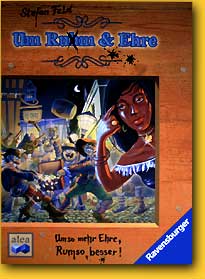 |
A die rolling game from Alea? Sure, and a lot of it too, in this latest Alea game. Flexible as we are, this does not have to be a problem, and with Alea we are curious how this will turn out. At least not very difficult, as the box indicates an age from 9 years, and a difficulty level of '2', the lowest rating so far for an Alea game.
The game is played on a variable board consisting of nine parts. After putting them together the board shows a nightly pirate town where the players can roam with their own band of pirates. This band consists of a total of fifteen pirates in the player’s colour, of which initially ten may be used. The town consists of a network of alleys that connects places of interest on the board. The lengths of the alleys vary from one to five spaces. At the beginning of the game each player is also dealt two coins for different expenses, and a card board flag indicating the player’s colour.
|
|
|
| x |
|
|
|
|
|
|
|
|
|
|
|
|
|
|
|
|
|
|
|
|
|
|
|
|
|
|
|
|
|
|
|
|
|
|
|
|
|
|
|
|
|
|
|
|
|
|
|
|
The intention is to follow the red pirate’s captain on his journey through pirate’s town. At the beginning of the game the red captain is placed on a unique location on the board.
On a player’s turn he can choose one on the following three actions:
1. move the pirate’s captain to another location
2. rest
3. go on board of the pirate’s ship to sleep
|
|
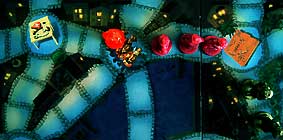 |
|
|
| x |
|
|
|
|
|
|
|
|
|
|
|
|
|
|
|
|
|
|
|
|
|
|
|
|
|
|
|
|
|
|
|
|
|
|
|
|
|
|
|
|
|
|
|
|
|
|
|
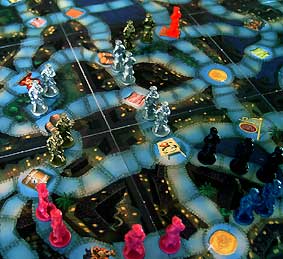 |
|
When the captain is moved, he is placed on one of the adjacent crossroads that is connected with an alley to its current location. On all spaces of this alley the player has to put a pirate from his supply. On the crossroads the player may then perform the action that corresponds with it. These actions could gain the player points, coins, or other advantages. A player is allowed to move the captain an extra turn but only when he pays for it with a coin.
Resting in fact means passing a turn. A coin must be paid to obtain this 'right'. No actions may be performed. When a player’s band of pirates is tired, he can opt going on board the pirate’s ship. All remaining pirates are placed on board the ship. When all players are on board, a brawl takes place for each of the three best sleeping spots. After this brawl, the players get their pirates back, and a new round is started; the game ends after five rounds. |
|
|
| x |
|
|
|
|
|
|
|
|
|
|
|
|
|
|
|
|
|
|
|
|
|
|
|
|
|
|
|
|
|
|
|
|
|
|
|
|
|
|
|
|
|
|
|
|
|
|
|
| The goal of the game is to collect the most points. This can be done with the actions during the rounds, or by winning a brawl for one of the best sleeping spots and getting points for it. A nice feature is that with a number of the actions not only the current player, but all the others may be involved. For instance, a visit of the captain to the pub may lead to a drinking spree. Each player that wants to join must pay a coin to the current player, after which a die is rolled for the applicable counters, which are worth from two to five points. Another action is the (blind) drawing of a 'date' counter. This counter shows a location somewhere on the board, together with a number of points. If the captain visits this location in the player’s turn, then the player may add this counter to its supply (under his flag). To increase a player’s supply of pirates, a visit to the recruitment location is necessary: one pirate is moved from the initial five unemployed supply to the player's supply. This action does not provide a direct point advantage, but a permanent personnel advantage throughout the remaining game. |
|
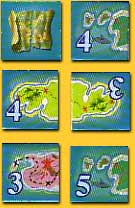  |
|
|
|
|
|
|
|
|
|
|
|
|
|
|
|
|
|
|
|
|
|
|
|
|
|
|
|
|
|
|
|
|
|
|
|
|
|
|
|
|
|
|
|
|
|
|
|
|
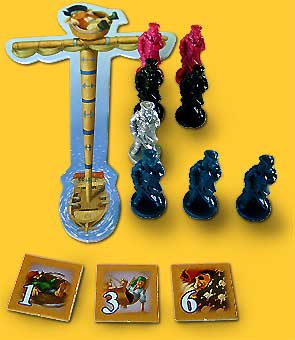 |
|
The crawls onboard are a dice fest as well. Using an elimination system, where the player with the most pirates on board has a statistic advantage, a die is thrown repeatedly for the best three sleeping spots - and then the die might prove the statistics were wrong!. The best spot may deliver up to eight points. Any rum counters previously collected may be used to reroll the die for a better result. These rum counters can be obtained as another of the possible actions during the round. In fact, these rum counters may be deployed to influence any other die battle as well.
|
| x |
|
|
|
|
|
|
|
|
|
|
|
|
|
|
|
|
|
|
|
|
|
|
|
|
|
|
|
|
|
|
|
|
|
|
|
|
|
|
|
|
|
|
|
|
|
|
|
| x |
|
|
|
|
|
|
|
|
|
|
|
|
|
|
|
|
|
|
|
|
|
|
|
|
|
|
|
|
|
|
|
|
|
|
|
|
|
|
|
|
|
|
|
|
|
|
|
 |
|
|
|
|
|
|
|
|
|
|
|
|
|
|
|
|
|
|
|
|
|
|
|
|
|
|
|
|
|
|
|
|
|
|
|
|
|
|
|
|
|
|
|
 |
|
|
|
|
|
|
|
|
|
|
|
|
|
|
|
|
|
|
|
|
|
|
|
|
|
|
|
|
|
|
|
|
|
|
|
|
|
|
|
|
|
|
|
 |
|
|
|
|
|
|
|
|
|
|
|
|
|
|
|
|
|
|
|
|
|
|
|
|
|
|
|
|
|
|
|
|
|
|
|
|
|
|
|
|
|
|
|
| x |
|
|
|
|
|
|
|
|
|
|
|
|
|
|
|
|
|
|
|
|
|
|
|
|
|
|
|
|
|
|
|
|
|
|
|
|
|
|
|
|
|
|
|
|
|
|
|
 |
|
|
|
|
|
|
|
|
|
|
|
|
|
|
|
|
|
|
|
|
|
|
|
|
|
|
|
|
|
|
|
|
|
|
|
 |
|
|
|
|
|
|
|
|
|
|
|
|
|
|
|
|
|
|
|
|
|
|
|
|
|
|
|
|
|
|
|
|
|
|
|
|
|